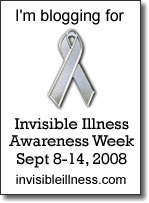 RSS FEED
RSS FEED
Archive for the ‘Communicating’ Category
Hello there Migraineurs – I’m Still Here!
December 30th, 2008
Hello dear readers – I think this may be my the longest break between posts since I started blogging last January. I apologize for leaving you alone so long! I’m happy to report that the reason for my silence is not that I’ve been off having Migraine attacks – well, not many. I’ve had two since I last spoke to you on December 11th – that’s a great 3 weeks for me! Actually I have felt well, and I have had the opportunity to do quite a bit more paid work, which made me quite busy, and which makes our family budget very happy! And then, of course, it has been the holiday season, and even with a toned-down, taking-it-easy and not-over-doing-it kind of holiday season, I’ve been busy with that!
It’s appropriate that my last post was about balance. Remember that see-saw. Balance is always about adjusting – it shifts, and shifts again. I’m in the middle of a big shift right now. I’m finding that I have more energy to work during the day, and more energy to be with my family and friends, and care for my home, than I have had for a long time. Where’s the energy coming from? I think the Topamax is working well for me. I think the relaxation practice is working well for me, and leading some of you in relaxation sessions has reinforced my own relaxation. I also think that adding CoEnzyme Q-10 to my supplement list has helped a lot. Just having fewer Migraines makes a world of difference. I didn’t even know how much constant low level head pain I was living with – until most of it went away over the past few months.
The other side of the see-saw is that I need to still find the time for this blog, for the writing and creating that is important to me, for staying connected with the Migraine community that sustains me. I need the reminder that I am not, will never be, and don’t need to be, Superwoman, and that I still need plenty of rest and down time.
I love this week between Christmas and New Year’s when things are quiet and slow. Yes, there are celebrations and parties, and yes we’ve been to some of them. Some people go away on vacation, and though we went visiting over the weekend, for the most part we are staying put. I catch up on all sorts of paperwork, get my files in order, straighten up. For some reason the tasks I put off and hate the thought of all year become very satisfying to get finished. It’s interesting to me that this year I really get a chance for a kind of a fresh start, with a new level of control over my Migraines, with new work to do, with my desk clear and files in order to make room for new things. Then whatever those new things turn out to be, they will have to be worked into the balance. The balance will shift.
Thanks to all of you for being on this journey with me this year – it has been one of great learning and growth for me, I hope it has for you too. If I don’t talk to you again in 2008 (25 hours of it to go!) I wish you a happy and healthy new year!
– Megan
Christmas see-saw image courtesy of Tomeppy.
Tags: CoEnzyme Q10, life balance, Migraine attack, Migraine management, Topamax
Posted in Communicating, Managing, Musings | Comments (2)
Radio Piece on Migraines, Neurological Illness, and More
November 20th, 2008
On Tuesday I had the great good fun to be interviewed by Coach Marla Martindale of  A Winning Life with RSD, along with her co-host Chris Tatevosian, author of Life Interrupted – It’s Not All About Me. Marla’s weekly radio show Winning Life Through Pain is on every Tuesday and deals with living well with chronic illness, and other health related topics. We talked about managing life with Migraine, Migraine myths and tips for coping, communicating about our illness, and how to calm down our nervous systems, as well as discovering a lot of similarities in dealing with other neurological illnesses like RSD and MS. Oh and there were a few references to baked bees and general silliness. You can discover that for yourself, if you like. Give a listen.
A Winning Life with RSD, along with her co-host Chris Tatevosian, author of Life Interrupted – It’s Not All About Me. Marla’s weekly radio show Winning Life Through Pain is on every Tuesday and deals with living well with chronic illness, and other health related topics. We talked about managing life with Migraine, Migraine myths and tips for coping, communicating about our illness, and how to calm down our nervous systems, as well as discovering a lot of similarities in dealing with other neurological illnesses like RSD and MS. Oh and there were a few references to baked bees and general silliness. You can discover that for yourself, if you like. Give a listen.
(Oh, a warning, it’s a big file – 27.4 MB, so you if you’d rather not deal with loading it, go to Winning Life Through Pain to listen.)
– Megan
Tags: chronic illness, migraine, neurological illness, radio, Weblogs
Posted in Advocacy, Communicating, Tips & Techniques, Weblogs | Comments (0)
Migraines on the Radio
November 17th, 2008
 Coach Marla of A Winning Life with RSD asked me to be on her internet radio show tomorrow (Tuesday, November 14) at Winning Life Through Pain. Please come give a listen; we’ll be on at 2:00 Eastern, 1:00 Central, 12:00 Mountain, 11:00 Pacific, talking about living with Migraine and other chronic illnesses. You can click on the link above to get to Blog Talk Radio and listen to the radio show. Hope your heads are treating you well today.
Coach Marla of A Winning Life with RSD asked me to be on her internet radio show tomorrow (Tuesday, November 14) at Winning Life Through Pain. Please come give a listen; we’ll be on at 2:00 Eastern, 1:00 Central, 12:00 Mountain, 11:00 Pacific, talking about living with Migraine and other chronic illnesses. You can click on the link above to get to Blog Talk Radio and listen to the radio show. Hope your heads are treating you well today.
– Megan Oltman
Microphone image courtesy of Matthew Keefe.
Tags: blog radio, chronic illness, migraine, reflex sympathetic dystrophy
Posted in Communicating, Tips & Techniques, Weblogs | Comments (0)
Is the Economy Hurting your Head?
October 27th, 2008
As you know from my recent posts, the costs of health care and our national tragedy of a broken  health insurance system have been hitting me where I live lately. Of course I’m far from alone in this. In the current economic crisis, people are finding it harder than ever to afford the medications and health care they need. In a study published on October 14, the National Headache Foundation (NHF) surveyed 270 headache sufferers on line recently, and found that more than three quarters of the respondents said they have cut back financially, and those cuts have impacted their headache treatment:
health insurance system have been hitting me where I live lately. Of course I’m far from alone in this. In the current economic crisis, people are finding it harder than ever to afford the medications and health care they need. In a study published on October 14, the National Headache Foundation (NHF) surveyed 270 headache sufferers on line recently, and found that more than three quarters of the respondents said they have cut back financially, and those cuts have impacted their headache treatment:
Migraineurs are not alone in this, of course, the New York Times reported last week that prescription drug sales are down, and people are cutting back on life saving medications for many medical conditions. The NHF’s survey also found that people were cutting back on certain types of food purchases, and were not sleeping as well and feeling more stress due to their economic situation. Sleep disturbances, anxiety and dietary changes were all cited as triggering increased headaches. Delaying or skipping filling prescriptions, or using over the counter medications as a substitute is a serious concern. It’s easy for me to say to you – don’t cut back on prescription medications! Find something else to cut back on! If the choice is between snack foods and prescriptions, definitely give up the snack foods. Unfortunately, many of my prescriptions have a $50 co-pay. I could save a lot more money delaying a $50 co-pay than going without a $3.89 box of donuts. Sometimes we are faced with real, terrible choices. Sometimes we have to choose what to do without, and there may be no truly right answer. I will not presume to advise you here – you must make your own choice. Some economic insecurity is very real. Some people lose their jobs, can’t get loans, lose their investments, don’t have health insurance, and have to make terrible choices. Please ask yourself whether you really need to forgo this expense, or whether it is just anxiety and fear for the future that is making your decision for you. The NHF has some suggestions for ways to afford your prescriptions:
- If you are unable to afford your medication, many pharmaceutical companies offer patient assistance programs. Talk to your doctor or visit the NHF Web site (www.headaches.org) and click on Headache Education-Tools for Sufferers for a list of available programs.
- Talk to your doctor about your financial situation; there may be a generic form of your prescription available.
 Beyond the nuts and bolts of paying for the prescriptions, though, you need ways to manage your stress and anxiety. I suggest snuggling a kitty if you can. NHF has some good advice, picking up on some familiar themes here at Free my Brain, they suggest you practice relaxation techniques and include exercise in your daily routine. Suzanne Simons, NHF Executive Director, concludes with a great piece of advice: “remember that the financial turmoil we are currently experiencing is temporary. …[T]he situation will get better and keeping a positive outlook may help lessen the emotional and physical impact of these volatile economic times.” Remember that economies are affected by attitudes. Refuse to give in to despair. Do whatever you can to make things better. And get out and vote for change!
Beyond the nuts and bolts of paying for the prescriptions, though, you need ways to manage your stress and anxiety. I suggest snuggling a kitty if you can. NHF has some good advice, picking up on some familiar themes here at Free my Brain, they suggest you practice relaxation techniques and include exercise in your daily routine. Suzanne Simons, NHF Executive Director, concludes with a great piece of advice: “remember that the financial turmoil we are currently experiencing is temporary. …[T]he situation will get better and keeping a positive outlook may help lessen the emotional and physical impact of these volatile economic times.” Remember that economies are affected by attitudes. Refuse to give in to despair. Do whatever you can to make things better. And get out and vote for change!
– Megan Oltman
Hand on head image courtesy of Mr. Thomas/Christopher.
Tags: economy, migraine, National Headache Foundation, prescription drugs, relaxation
Posted in Communicating, Current Affairs, Managing, Medicine, Tips & Techniques | Comments (3)
Migraine News from Between my Ears
October 17th, 2008

A funny thing happens when you start blogging. There is this little bit of celebrity that arises. I can admit that like many people I once secretly wanted to be famous. My friend Laura told me in High School that she pictured me as a kind of revolutionary leader, with thousands chanting my name. If that had ever been my ambition, I’d have to say that I failed miserably. I’ve made it through nearly 50 years of life and I don’t think even dozens have ever chanted my name. Not at the same time, anyway.
But I digress. I started this blog for a few reasons. I wanted a place to share my thoughts on living with Migraine disease, and the other chronic illnesses I live with. I particularly wanted to share my hope and strength, as someone who has come a long way in managing a life with these conditions. I wanted to join the warm, intelligent, funny and committed community of Migraine and headache
bloggers and advocates who are making such a difference in the lives of patients and in advancing the understanding of this disease. The big reason was this moment of  truth I had almost a year ago, when I realized that my chronic illnesses are not just an impediment in my life; they
truth I had almost a year ago, when I realized that my chronic illnesses are not just an impediment in my life; they
are an opportunity to
share my professional tools and skills, and the
wisdom I have accumulated, to help others manage their lives with
Migraine. I wrote a bit more about that a few months back in My Migraine Story.
I didn’t really start the blog to keep the world posted on the doings in my own life. I tell a lot of stories, partly because I come from a family of storytellers,and partly because I’ve always made points (with clients and anyone who will listen) by telling personal stories, about things that happen and lessons I learn. So it’s been a lot of fun doing that here. And lo and behold, I learn that people are actually following (to some extent) what’s going on in my life. Little old me, Megan, Rachel & Adam’s Mom, Danny’s wife, Joan & Jim’s daughter, Jon & Ellen’s sister, the lady in the house on the corner by the field, the little red-head… that one. It’s a small and gentle sort of celebrity, but I find when I don’t follow up on things I’ve mentioned, sure enough, you’re actually listening, and sometimes you ask.
- I’m looking for an allergist to determine whether I should even pursue this Medication Allergy challenge test idea, because as my friend Medieval Writer of Sparkling with Crystals reminds me, anaphylactic shock can potentially kill you faster than a doctor can save you, even in the hospital with a crash cart standing by.

- I’m spending a little time, just a few calls here and there, my head and energy levels allowing, volunteering for Barack Obama’s campaign. Please get out and vote for better health care! You don’t have to chance feeling well enough on election day; you can vote early in many states – go to Rock the Vote to check your state’s rules.
- My difficulties with the Topamax are settling down. We’ll see what happens when I go back to Dr. G and increase the dose next week! Tingling has disappeared and the cognitive effects are fading. An unexpected benefit seems to that it is
 functioning as an anti-anxiety med for me! I am a pretty
functioning as an anti-anxiety med for me! I am a pretty
anxious person by nature, and I tend to obsess on things, but it seems like the slight loss of focus I have on the Topamax means I can’t focus on something long enough to really obsess and get anxious! Kind of weird – but I’m just not worrying as much! MaxJerz of Rhymes with Migraine pointed me towards this piece on Health Central’s Anxiety Connection indicating that Topamax is sometimes prescribed in combination with other drugs to treat anxiety. Who knew? (Well obviously, someone did, but not me!) - I don’t think the Topamax is having a major inhibiting effect on my Migraines yet, though I haven’t had a really bad one in the month I’ve been on it. I am doing a very slow titration to minimize side effects and will probably increase the dosage when I see my HA specialist next week. Judith Warner wrote a pretty good piece about her difficulties with Topamax (not named, but quite identifiable) in the NYTimes today, but they didn’t publish my comment. I am trying not to take it personally!
- Our Health Insurance Hassles and Headaches may turn out to be a blessing in disguise, NO

thanks to Oxford (who I will still refer to as the insurer from hell) because it looks like there are a range of better, more affordable options out there for us. I got a lot of info that may help others, too, and will try to do a whole post on it soon. For others who are struggling with insurance, if you have children, be sure to check out your state’s insurance coverage for children. Some states now extend that to parents of children 18 and under. I know this is no help for childless people or those whose kids are grown; you deserve health insurance too! - In the meantime, I seem to be developing a lot of Acephalgic, or Silent, Migraines (phono & photo-phobia, dizziness, without head-pain) in the evenings. It’s better than having the head pain, but still means I have to retreat to my cave (i.e. bedroom) for the evening and can’t hang out with the family much. Bummer. More to talk to Dr. G about next week.

- And, (a drumroll please…) my biggest news… by next week (I hope) I should be launching my new website, containing this blog and other resources for Migraineurs, including relaxation teleclasses – stay tuned for more! Hard at work on it now – soft greens and yellows – looking pretty – can’t wait…
Hope your heads treat you well and you have an AWAP weekend!
– Megan Oltman
Tags: acephalgic Migraine, Adam Oltman Porcher, Adam Porcher, chronic illness, health insurance, medication allergies, Migraine disease, Topamax, vote
Posted in Communicating, Current Affairs, Musings, Weblogs | Comments (4)
How Am I? As Well As Possible, Thank You!
September 13th, 2008
 AWAP has been making the rounds on some of the Migraine forums lately – so I googled it and got many choices:
AWAP has been making the rounds on some of the Migraine forums lately – so I googled it and got many choices:
Abused Women’s Advocacy Project
Any Word Any Page
Aftermarket Wholesale Autobody Parts
Animal Welfare Audit Program
All worthy choices, I’m sure, but…
I’m talking about As Well As Possible. A wish for the chronically ill – not, “have a great day!” But “have an AWAP day!” Not “I’m feeling fine!” But “I’m feeling AWAP!” I sign off on notes and emails to my chronically ill clients and friends, “wishing you pain-free days and nights.” It is my wish for them, my earnest wish, and it is my wish for myself. But sometimes it’s unrealistic. We must walk a fine line between powerful hope and attainable goals. Between reaching for the stars, setting our sights high, and accepting the reality of our lives. I work and strive for the day when my Migraines, and yours, are a thing of the past. But if I expect that to be today, I may be setting us both up for disappointment.
When I was little, I was taught that when people asked how I am, I was to say, “Fine thank you, how are you?” The explanation for that stock answer is that people are asking in order to be polite, and they don’t really want to know! Is that true? Sometimes it is. Every person I encounter in business, every acquaintance I run into in the grocery store, does not necessarily want to hear the details of my illnesses. I don’t necessarily want to share and go into it with all of them either. So what do I say? I  try to avoid saying “fine.” I often say I’m okay. Or not bad. On those occasions when I feel great, I say I feel great. (Hey, it does happen!) But if I say I’m fine when I’m not, I’m perpetuating the invisibility of my illness.
try to avoid saying “fine.” I often say I’m okay. Or not bad. On those occasions when I feel great, I say I feel great. (Hey, it does happen!) But if I say I’m fine when I’m not, I’m perpetuating the invisibility of my illness.
With people in my life, I try to strike a balance between being real and being upbeat.
- Why be real? Because the people that care about me do want to know and because I want them to know; they are part of my support system.
- Why be upbeat? Because I don’t want them to worry and because the more upbeat I am, the better my life is.
When we live with chronic illness it is very important to enjoy as much as we can of life. To find the joy where we can. And so for me to be AWAP means that I am living the best I can today, maintaining a sense of humor, being productive where I can, having as much fun as I can. It means that I may be chronically ill but I am not overcome by it.
 Sometimes my friends and relatives say, “How’s your head?” or “Having any Migraines lately?” or even “I hope you haven’t had any of those Migraines,” or “Migraines better?” Of course people want me to be better. I want to be better too. When a friend is ill, we want them better. What else can we wish them? So I try to find an answer that acknowledges their caring, and acknowledges my reality. Today I am As Well As Possible. I am not in constant pain. The on and off Migraines I’ve been having for weeks are off at the moment. I have some energy and I am getting some things done. My dishwasher is fixed. My kids make me laugh. The field is full of deep yellow goldenrod and deep purple asters. I am grateful for my life. AWAP
Sometimes my friends and relatives say, “How’s your head?” or “Having any Migraines lately?” or even “I hope you haven’t had any of those Migraines,” or “Migraines better?” Of course people want me to be better. I want to be better too. When a friend is ill, we want them better. What else can we wish them? So I try to find an answer that acknowledges their caring, and acknowledges my reality. Today I am As Well As Possible. I am not in constant pain. The on and off Migraines I’ve been having for weeks are off at the moment. I have some energy and I am getting some things done. My dishwasher is fixed. My kids make me laugh. The field is full of deep yellow goldenrod and deep purple asters. I am grateful for my life. AWAP
– Megan Oltman
Tags: chronic illness, invisilbe illness, Migraine disease
Posted in Advocacy, Communicating, Managing | Comments (8)
Can You See my Pain? Can I See my Pain?
September 8th, 2008
It’s Invisible Illness Awareness Week, a worldwide effort to bring together people who live with invisible  chronic illness and those who love them.
chronic illness and those who love them.
According to the Invisible Illness Blog, nearly 1 in 2 Americans have some kind of chronic illness. From heart disease to mental illnesses, cancer, lupus, chronic fatigue, Migraine and headache disorders and many others, people are suffering all around. While our illnesses may be invisible, giving no outward visual signs, why are they so unknown to those around us?
The statistics on Migraine disease are staggering.
- About 12% of the human population has Migraine disease (at any given time). That’s about 1 out of every 8 people you know.
- About 20% of the human population will have Migraine disease at some time in their lifetime (since it may develop in childhood, adolescence or adulthood, and since it sometimes fades or disappears with age). That’s about 1 out of every 5 people you know!
- About 47% of Migraineurs have 3 or more Migraine attacks per month. That’s about 1 out of every 17 people you know!
Given those numbers, why is this disease so misunderstood, un-researched, underfunded, and the treatment options so undeveloped? Why do so many people, even doctors, think it’s “just a headache”? There’s enough for several more posts in answer to that question, but I think invisibility is one of the major reasons.
 Think about the invisibility of head pain. Unless someone is highly attuned to changes in our eyes and expressions, or the cue of hand to forehead, they will not know when we have a Migraine attack. It’s not like they can see the hammer knocking us on the head! Even more significantly, perhaps, it’s hard for others to understand how we might feel fine today, but be unable to get out of bed tomorrow. It’s hard to understand the long term consequences of frequent or chronic pain. Migraine can increase stroke risk, and Migraine disease can cause brain damage over time: this is recent knowledge.
Think about the invisibility of head pain. Unless someone is highly attuned to changes in our eyes and expressions, or the cue of hand to forehead, they will not know when we have a Migraine attack. It’s not like they can see the hammer knocking us on the head! Even more significantly, perhaps, it’s hard for others to understand how we might feel fine today, but be unable to get out of bed tomorrow. It’s hard to understand the long term consequences of frequent or chronic pain. Migraine can increase stroke risk, and Migraine disease can cause brain damage over time: this is recent knowledge.
There is much we can do to educate others, to explain to those around us, to rally for more research, to insist on accommodations at work and adequate treatment from doctors, emergency rooms, and insurance companies. But I think one foundation of the problem lies in how invisible this illness even to ourselves.
Last week I practiced saying “I am chronically ill.” I said it to a number of different people, and told it to myself in the mirror. Big deal? It is a big deal. It is the reality of my life for most of the last 13 years, yet I have a very hard time accepting it. I am a meticulous record keeper. I keep a very detailed Migraine and Wellness diary where I track not only Migraines but my sinus infections, my fatigue, and my dizziness, among other things. I can tell you that over the past 4 years, I have been sick, with my ability to function significantly reduced, 25% of the time. It’s probably higher than that, because I have a lot of Migraines in the evening, but if I have worked and functioned most of the day, I have counted that as a well day.
I am one of the lucky ones. Many chronically ill people are sick more than half the time. Since I am in business for myself, I can set my work up to be flexible and take the time I need for myself. My ability to meet deadlines and my income do suffer. Imagine having a job, and needing to take 6 sick days per month. That’s what my numbers translate to.
Those are the facts, and yet it is very hard to accept that I am chronically ill. If you’re not sick every day, it’s easy to fall into denial again. To forget that there are limitations to what I can do. That even when I feel great I need to be very cautious and marshal my energy. That things I used to do are not
available to me any more. That I need to adjust the standards I have measured myself by.
I need to be as kind, forbearing, patient, understanding and loving towards myself as I would be to a friend who was chronically ill. Why is that so hard? I need to accept where I am without giving up hope, and while still striving to take better care of myself, get better treatment, do everything I can to be as well as I can be.
When I am caring for myself in this way (and I do manage it at times), it is easier for me to be real with the people around me. To explain my illness, to help them understand. I need to have my illness visible to me; then I can help make it visible to others.
– Megan Oltman
Tags: chronic illness, invisible illness, migraine
Posted in Advocacy, Communicating, Managing | Comments (2)
August Blog Carnival on Dealing with Those who Don’t “Get It”
August 18th, 2008
August Headache Blog Carnival. Slow and steady wins the race? I’m a week behind here, but it’s not too late for you to go read lots of good blog posts on the topic of “Dealing With People Who Don’t ‘Get’
It.” It’s posted over at Diana Lee’s Somebody Heal Me. Many thanks to Diana for another great collection of blog posts. I’m particularly partial to James Cottrill’s “How to Introduce a Migraine.” Try out “The World Health Organization says I have one of the world’s top 20 disabilities. Guess which one!”
Generally speaking, a blog carnival is a collection of links to a
variety of a blogs on a central topic. The Headache & Migraine Disease Blog
Carnival has been created to provide both headache and migraine
disease patients and people who blog about headache disorders with unique
opportunities to share ideas on topics of particular interest and importance to
us. Visit the link to this month’s carnival for a collection of
informative entries on basic strategies for coping with migraines and
headaches.
Entries for the September 2008 Headache & Migraine Disease Blog Carnival on the theme of “Tips on Improving Doctor & Patient Relationships“ are due by the end of the day on Friday, September 5th.particularly useful, educational or inspirational for headache and migraine sufferers are also welcome. Posts may be submitted through the form on the carnival website.
Posts that relate to the September carnival’s theme will receive preference. Entries on topics that are
Tags: Migraine disease, Weblogs
Posted in Communicating, Weblogs | Comments (0)
Handling Migraine Challenges: Helping Others Understand
July 19th, 2008

I’ve been asking e-course subscribers* what they find to be the biggest challenge in managing their Migraines. Many of you have responded. While I’ve written individually to everyone who responded, we all have so much in common that I wanted to share some of what I’ve gathered from your responses. This is kind of Megan’s Dear Abby for Migraineurs.
We all know that we are challenged in many ways by Migraine disease, but the majority of subscribers included something along the lines of “helping others understand.” How do we help others, the non-migraineurs who are important in our lives, to understand our disease, how it effects us, what we can and can’t do about it, and how it will effect them?
In reading all your responses, I see two issues in helping people understand.
The first is coping with those who judge us. “Oh it’s just a headache she’s being a baby.” “Oh so you have another of your little headaches?” “Why do you always have a Migraine when I need you to do something?”
People have all kinds of reasons for judging. Sometimes they want to feel superior. They may want to distance themselves from you, your problems, your pain. It’s almost a superstition at times; if they don’t sympathize, if they don’t believe in your pain, they can pretend it has nothing to do with them, that nothing like this can ever happen to them. Some disability advocates refer to the non-disabled as “TABs” – standing for Temporarily Able-Bodied. A potent reminder that disease and disability can happen to any one of us.
What can we do with those trying to feel superior? We can think of nasty responses to put them in their place, and that can be a fun exercise when we’re angry. The only thing I think is really effective is to speak our truth – tell the truth about what it’s like for us. Some of those people will hear. Some of it will sink in. This is more about Coming Out of the Migraine Closet. And if these people are not important to us, how much do we really need to do? We can choose how far, and when, we want to be advocates, and we can recognize that not everyone will understand us, not everyone will be our best friend. The job of advocacy takes a long time, and while I believe in educating people, it’s okay not to face down every single person every single time.
When important people judge us, the people that matter in our lives, I believe they do it out of pain. There is the pain of what they lose to Migraine disease. Our companionship, having fun with us, our help, our ideas, our input. Our work and productivity. There is the pain of seeing us in pain. Of wanting to help. Particularly in the case of parents and life partners, there is the pain of wanting to be able to fix it, make
it all better, make it go away. The pain of their powerlessness in the face of this disease. When we can’t face pain, or understand it. we look for someone or something to blame. “Why can’t you take better care of yourself?” “It’s all in your head.” “You have to learn not to stress out.”
The answer is in communication. If people care about us, it’s worth doing whatever it takes to help them understand. To sit down, at a time when no one is upset, and tell them what it’s like for us. Give them information they may not have about this disease. Teri Robert has a great resource, Understanding Migraine Disease and Migraineurs, which is a letter you can give to those who don’t understand.
But this brings us to the second issue, which I suspect is actually a bigger issue than what the others think. First, before we can ask them to understand, we have to understand ourselves. I think this may be the biggest ongoing challenge. We have to understand, and accept, that we have a disease. We didn’t choose it. We didn’t cause it. We may be scared, confused, upset, frustrated, worn down and in pain. But we are not lazy, we are not malingering and we are not making it up.
Even more of you wrote about your worries about effecting others than about actual judgment from others. “Feeling like I’m a burden on my family.” “This disease affects everybody around me and it’s not fair. Neither for me nor for the others.” “Having to stay in bed and my hubby having to take over.” “I want my clients to be able to depend on me but sometimes I cannot be there and that really bothers me.”
We want to be useful, to be helping and participating with those we care about. The first thing we have to do is to accept that we have a disease that will interrupt our lives, take us out of the action, make us rely on others. Inside of acceptance, we can begin to see how we can help, what we can do. Inside of understanding, we have options.
– Megan Oltman
*The Six Keys to Manage your Migraines and Take Back your Life – sign up for this free e-course in the upper right corner of this page.
Writing pen image courtesy of Toshiyuki IMAI; pointing finger image courtesy of Lisamarie Babik.
Tags: acceptance, disability, e-course, Migraine disease
Posted in Advocacy, Communicating, Managing | Comments (5)
Coping with Migraine: Claims of a “Cure”
June 27th, 2008
I was recently presented with a dilemma here on Free my Brain. I want to encourage dialog and exchange of ideas, but I don’t intend to provide an open marketplace for sale of migraine “cures.” (Though I will gladly support and even promote helpful products and services.) Migraine is a complex, genetically based, neurological disease. The frequency and severity of migraines vary enormously from person to person; so do the number and complexity of triggers and other contributing factors. What we know now is that this is a neurological disorder, a differently ordered nervous system, if you will, which has existed throughout human history. Like many congenital conditions, there may have been a valid evolutionary reason for this mutation at one point. Maybe migraineurs were the human barometers, predicting disastrous weather changes for primitive societies. I had fun speculating on the evolutionary basis of migraine in the post Our Ancestress: A Fable.

I have heard from many people who have done just one thing and their migraines have gone away. To them I can only say mazel tov! (Congratulations!) Here is a bouquet of flowers to celebrate! For some it is eliminating just one trigger. For others it is a particular nutritional supplement, a practice of meditation, regular exercise, a medication, a surgery, pregnancy, menopause, a life or lifestyle change. I don’t know if there are statistics on how many migraineurs find relief from just one thing. I do know there are large numbers of us out here who need to find a combination of factors to manage and control our migraines. Here is a bouquet of flowers to console us! There is no “cure” for a genetically based neurological condition, any more than there is a “cure” for my red hair and green eyes. (Well, another 15 – 20 years may pretty well eliminate the red hair.)
A great place for some very basic facts and information about Migraine is the recent quiz at My Migraine Connection: Dispelling Migraine Myths. The two books on migraine featured in the left side-bar on this page are both great resources for learning about migraine and how to manage it. There is much we can do. For most of us, we can reduce our migraines significantly. You have probably heard me say before that I have reduced my own migraine frequency by about 50% through use of abortive medications, supplements, trigger avoidance, relaxation and meditation, and lifestyle changes.
Someone submitted a comment to one of my posts stating that 1) Migraine isn’t a disease; 2) there is a cure for Migraine “within us;” 3) he had over 20 years of migraines which are now gone; and 4) you can “retrain” yourself so you have no more migraines; he then went on to promote his methods. I am genuinely happy for the commenter that his migraines are gone. I am certainly curious about his methods, and glad that he wants to help others. I don’t mean to suggest he had any but the best motives. But I am wary of anyone’s claim to have a cure. After some deliberation, I decided not to publish the comment and link.
There are two ways to look at “retraining.” A nervous system which can be easily triggered into a Migraine attack can be viewed as an over-excitable or hyper-reactive nervous system. Regular practice of meditation and relaxation can help us reduce the excitability of our nervous systems. Note that this is not a “cure;” it is a supportive exercise or practice which can strengthen our system’s ability to resist triggers. You could call this “retraining.”
But there is another view of retraining which comes from an idea that Migraine disease is psychologically generated. It is not. It is a real, physical condition. It is no more psychological than epilepsy or scoliosis. I view with rage books like Louise Hay’s “You Can Heal Your Life” which suggest that right thinking can solve all our medical problems. She suggests that “Migraine headaches are created by people who want to be perfect and who
create a lot of pressure on themselves. A lot of suppressed anger is
involved…” 
And so, if we work like crazy in therapy, meditate, recite mantras and do whatever highly subjective steps Hay seems to think will enable us to let go of the anger and pressure, if we do all that and we still have Migraines, then what? We failed? It’s like telling someone the devil is causing their Migraines and they just have to really believe in God. “I do believe!” “If you really believed the devil would leave you and your Migraines would be gone!” “But I really do believe…” It’s just a very sneaky way of blaming the victim!
I wish we could do a scientific study of people who want to be perfect and who put pressure on themselves. In the first place I bet you that’s at least 75% of the population. And I bet you dollars to donuts that 12% of all the perfectionists would turn out to have Migraine disease. And I bet that 12% of all the non-perfectionists would have Migraine disease too. What’s the incidence of Migraine disease in the general population? 12%! I think you get my point.
I have been told that if I only distinguished the beliefs from my past that were making me have Migraines, they would disappear. I will admit I tried to do that. Like anyone else, I have a past and beliefs were formed in it! Some of those beliefs are limiting to me. In a life of nearly half a century, with plenty of self-help, support groups, personal development courses, and therapy, I think I’ve managed to identify most of those beliefs. So why am I not cured of Migraines? Is it my fault? Or, wait, could it be that I have a genetically based, incurable neurological condition? Hmmm… Which is the more logical conclusion? And which is more empowering?
For me, the answer is clear. I am 49, a woman, 5’2″, a redhead, a migraineur. These are facts. I get choices about what I do with those facts. I am choosing to vigorously pursue better and better Migraine management. I am not wasting my mental or emotional energy on “cures.” Or at least I won’t, once I’m done with this rant!
– Megan Oltman
Curing is good for meats, cheeses, wines, paints… Maybe our heads don’t need it?
Hammer image courtesy of Darren Hester
Tags: blaming the victim, evolution, genetics, Louise Hay, meditation, Migraine disease, Migraine management, nervous system
Posted in Books, Communicating, Managing, Medicine, Rant, Science | Comments (4)
That disclaimer thing...
Remember: nothing we do here is medical advice or treatment or is a substitute for medical advice or treatment. Get competent medical advice to learn more about your migraines, possible treatments and risks.
What's New on Migraine Support Group Coaching |
Recent Comments
- on Calling all Redheaded Migraineurs
- on No, You’re not Crazy, You just Have Migraines
- on No, You’re not Crazy, You just Have Migraines
